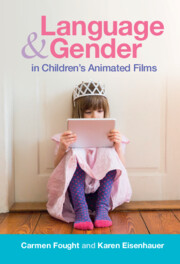Book contents
- Language and Gender in Children’s Animated Films
- Language and Gender in Children’s Animated Films
- Copyright page
- Dedication
- Contents
- Figures
- Tables
- Preface
- Acknowledgments
- 1 Introduction
- 2 Gender, Disney, and Pixar in Historical Context
- 3 Representation, Speech Amounts, and Talkativeness
- 4 Compliments
- 5 Directives
- 6 Insults
- 7 Apologies
- 8 Representing Queerness
- 9 Conclusion
- References and Filmography
- Index
5 - Directives
Published online by Cambridge University Press: 01 September 2022
- Language and Gender in Children’s Animated Films
- Language and Gender in Children’s Animated Films
- Copyright page
- Dedication
- Contents
- Figures
- Tables
- Preface
- Acknowledgments
- 1 Introduction
- 2 Gender, Disney, and Pixar in Historical Context
- 3 Representation, Speech Amounts, and Talkativeness
- 4 Compliments
- 5 Directives
- 6 Insults
- 7 Apologies
- 8 Representing Queerness
- 9 Conclusion
- References and Filmography
- Index
Summary
This chapter presents a quantitative analysis of directives and the variation in their syntactic forms as related to gender and power. Directives are defined as speech acts in which a speaker attempts to get the recipient to carry out or refrain from action. This chapter focuses on who gives and receives directives, and more specifically on the function of linguistic mitigation strategies and how they correlate with the gender of the speaker and addressee in Disney and Pixar films. The issuing of directives is very common in Disney and Pixar films; because they are an essential plot element, their frequency is unrelated to gender. However, the use of mitigation as a politeness strategy is strongly correlated with gender in both Disney and Pixar, independent of other important contextual variables such as urgency and institutional power (p < .01 for both data sets). In the films, male authority is shown as hierarchical, direct, and aggressive; female authority is shown as subtle, and based on persuasion, suggestion, and collaboration — a pattern which echoes research findings on real-life behavior across a number of contexts.
- Type
- Chapter
- Information
- Language and Gender in Children's Animated FilmsExploring Disney and Pixar, pp. 105 - 130Publisher: Cambridge University PressPrint publication year: 2022

